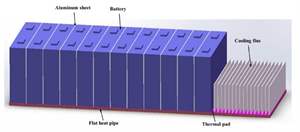
Flying cars are no longer reserved for sci-fi novels, with groups like Boeing, Toyota and NASA working to move electric vehicles into the skies. One of the key challenges is ensuring the power batteries in these airborne automobiles don’t overheat during takeoff and landing, when discharge rates peak.
Flat heat pipe (FHP) technology offers a promising solution. Thanks to its high heat conductivity and large surface area, it can effectively dissipate the heat from battery packs and ensure uniform temperatures within them. So WISE researcher Michael Fowler and his colleagues set out to explore its potential in battery thermal management systems for flying cars.
They started by developing a thermal model of the batteries that allowed them to examine how the state of charge, battery temperature and current affect the amount of heat produced. Next, they integrated an FHP system to analyze its cooling effects. They examined thermal performance at different discharging conditions, including both steady rates and the dynamic discharge rates expected during flying car operation.
Fowler and his colleagues also conducted preliminary experiments with different FHP configurations. By placing the batteries and cooling fins on opposite surfaces of the FHP, they were able to keep batteries cool more than 80 per cent of the time during the discharge rates required for flying cars.
Their results show that using FHP systems can be an effective way to lower the battery’s maximum temperature and handle operational requirements — bringing electric flying cars one step closer to reality.
Researchers: Michael Fowler, Yueqi Wang, Dan Dan, Yangjun Zhang, Yuping Qian, Satyam Panchal, Weifeng Li, Manh-Kien Tran, Yi Xie
Partners: National Natural Science Foundation of China, State Key Laboratory of Automotive Safety and Energy
Source: Wang, Y., Dan, D., Zhang, Y., Qian, Y., Panchal, S., Fowler, M., Li, W., Tran, M-K., & Xie, Y. (2022). A novel heat dissipation structure based on flat heat pipe for battery thermal management system. International Journal of Energy Research, 46 (11), 15961-15980.